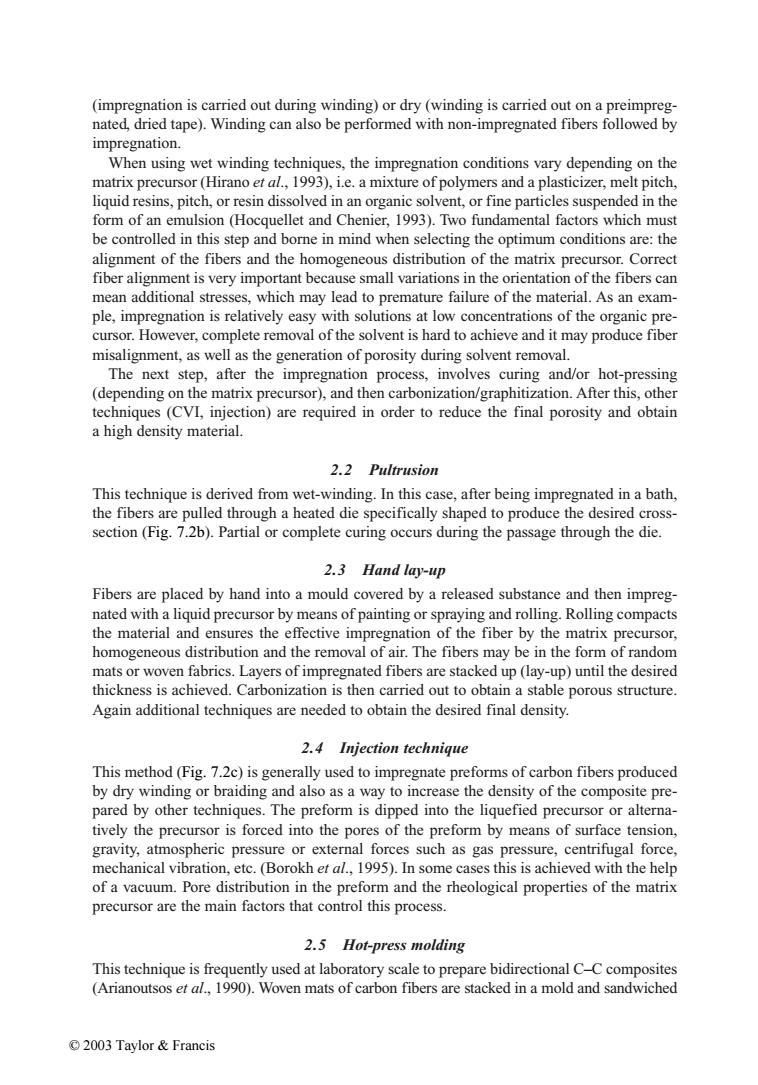正在加载图片...

(impregnation is carried out during winding)or dry(winding is carried out on a preimpreg- nated,dried tape).Winding can also be performed with non-impregnated fibers followed by impregnation. When using wet winding techniques,the impregnation conditions vary depending on the matrix precursor(Hirano et al.,1993),i.e.a mixture of polymers and a plasticizer,melt pitch, liquid resins,pitch,or resin dissolved in an organic solvent,or fine particles suspended in the form of an emulsion(Hocquellet and Chenier,1993).Two fundamental factors which must be controlled in this step and borne in mind when selecting the optimum conditions are:the alignment of the fibers and the homogeneous distribution of the matrix precursor.Correct fiber alignment is very important because small variations in the orientation of the fibers can mean additional stresses,which may lead to premature failure of the material.As an exam- ple,impregnation is relatively easy with solutions at low concentrations of the organic pre- cursor.However,complete removal of the solvent is hard to achieve and it may produce fiber misalignment,as well as the generation of porosity during solvent removal. The next step,after the impregnation process,involves curing and/or hot-pressing (depending on the matrix precursor),and then carbonization/graphitization.After this,other techniques(CVI,injection)are required in order to reduce the final porosity and obtain a high density material. 2.2 Pultrusion This technique is derived from wet-winding.In this case,after being impregnated in a bath, the fibers are pulled through a heated die specifically shaped to produce the desired cross- section(Fig.7.2b).Partial or complete curing occurs during the passage through the die. 2.3 Hand lay-up Fibers are placed by hand into a mould covered by a released substance and then impreg- nated with a liquid precursor by means of painting or spraying and rolling.Rolling compacts the material and ensures the effective impregnation of the fiber by the matrix precursor, homogeneous distribution and the removal of air.The fibers may be in the form of random mats or woven fabrics.Layers of impregnated fibers are stacked up(lay-up)until the desired thickness is achieved.Carbonization is then carried out to obtain a stable porous structure. Again additional techniques are needed to obtain the desired final density. 2.4 Injection technique This method(Fig.7.2c)is generally used to impregnate preforms of carbon fibers produced by dry winding or braiding and also as a way to increase the density of the composite pre- pared by other techniques.The preform is dipped into the liquefied precursor or alterna- tively the precursor is forced into the pores of the preform by means of surface tension, gravity,atmospheric pressure or external forces such as gas pressure,centrifugal force, mechanical vibration,etc.(Borokh et al.,1995).In some cases this is achieved with the help of a vacuum.Pore distribution in the preform and the rheological properties of the matrix precursor are the main factors that control this process. 2.5 Hot-press molding This technique is frequently used at laboratory scale to prepare bidirectional C-C composites (Arianoutsos et al.,1990).Woven mats of carbon fibers are stacked in a mold and sandwiched ©2003 Taylor&Francis(impregnation is carried out during winding) or dry (winding is carried out on a preimpregnated, dried tape). Winding can also be performed with non-impregnated fibers followed by impregnation. When using wet winding techniques, the impregnation conditions vary depending on the matrix precursor (Hirano et al., 1993), i.e. a mixture of polymers and a plasticizer, melt pitch, liquid resins, pitch, or resin dissolved in an organic solvent, or fine particles suspended in the form of an emulsion (Hocquellet and Chenier, 1993). Two fundamental factors which must be controlled in this step and borne in mind when selecting the optimum conditions are: the alignment of the fibers and the homogeneous distribution of the matrix precursor. Correct fiber alignment is very important because small variations in the orientation of the fibers can mean additional stresses, which may lead to premature failure of the material. As an example, impregnation is relatively easy with solutions at low concentrations of the organic precursor. However, complete removal of the solvent is hard to achieve and it may produce fiber misalignment, as well as the generation of porosity during solvent removal. The next step, after the impregnation process, involves curing and/or hot-pressing (depending on the matrix precursor), and then carbonization/graphitization. After this, other techniques (CVI, injection) are required in order to reduce the final porosity and obtain a high density material. 2.2 Pultrusion This technique is derived from wet-winding. In this case, after being impregnated in a bath, the fibers are pulled through a heated die specifically shaped to produce the desired crosssection (Fig. 7.2b). Partial or complete curing occurs during the passage through the die. 2.3 Hand lay-up Fibers are placed by hand into a mould covered by a released substance and then impregnated with a liquid precursor by means of painting or spraying and rolling. Rolling compacts the material and ensures the effective impregnation of the fiber by the matrix precursor, homogeneous distribution and the removal of air. The fibers may be in the form of random mats or woven fabrics. Layers of impregnated fibers are stacked up (lay-up) until the desired thickness is achieved. Carbonization is then carried out to obtain a stable porous structure. Again additional techniques are needed to obtain the desired final density. 2.4 Injection technique This method (Fig. 7.2c) is generally used to impregnate preforms of carbon fibers produced by dry winding or braiding and also as a way to increase the density of the composite prepared by other techniques. The preform is dipped into the liquefied precursor or alternatively the precursor is forced into the pores of the preform by means of surface tension, gravity, atmospheric pressure or external forces such as gas pressure, centrifugal force, mechanical vibration, etc. (Borokh et al., 1995). In some cases this is achieved with the help of a vacuum. Pore distribution in the preform and the rheological properties of the matrix precursor are the main factors that control this process. 2.5 Hot-press molding This technique is frequently used at laboratory scale to prepare bidirectional C–C composites (Arianoutsos et al., 1990). Woven mats of carbon fibers are stacked in a mold and sandwiched © 2003 Taylor & Francis